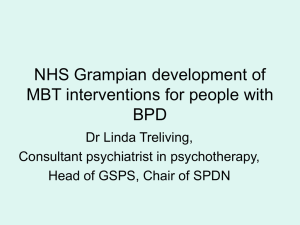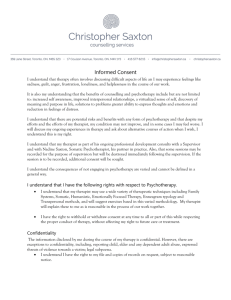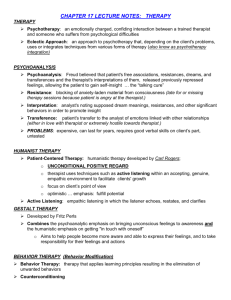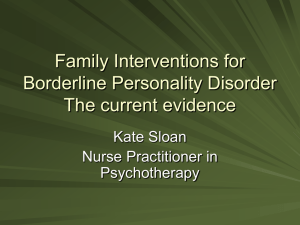What should we do and not do in treatment of borderline personality
advertisement
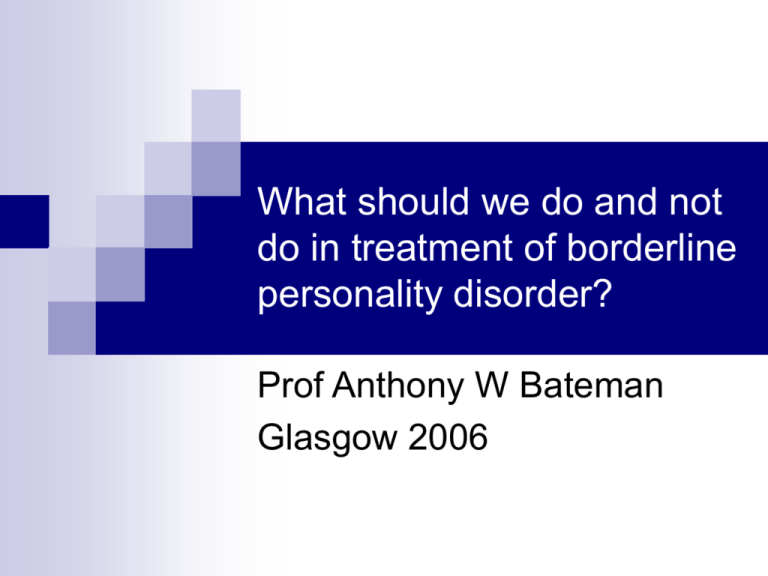
What should we do and not do in treatment of borderline personality disorder? Prof Anthony W Bateman Glasgow 2006 Acknowledgments St Ann’s Hospital, London Catherine Freeman Rory Bolton Countless other clinicians University College, London Prof Peter Fonagy Dr Mary Target Dr Liz Allison Menninger/Baylor Department of Psychiatry Dr Efrain Bleiberg, Dr Jon Allen Therapies for BPD Supportive Psychotherapy Behavioural Dialectical Behaviour Therapy (DBT) Cognitive Manual Assisted Cognitive Therapy (MACT) Schema Focused Psychotherapy (SFP) Psychoanalytic Transference Focused Psychotherapy (TFP) Mentalization Based Treatment (MBT) Outcomes (selected) at baseline &12 months in MACT and TAU groups Tyrer, P., Tom, B., Byford, S., et al (2004) Differential effects of manual assisted cognitive behaviour therapy in the treatment of recurrent deliberate self-harm and personality disturbance: the POPMACT study. Journal of Personality Disorders, 18, 102-116. HADS dep HADS anx MACT TAU Baseline 12 months Baseline 12 months 11.3 14.0 7.0 11.2 10.3 14.3 7.1 10.3 Social function 13.3 9.8 13.3 10.3 (n=400) (n=400) GAF symptoms (n=402) 18.7 61 18.6 62 Summary of clinical findings Tyrer, P., Tom, B., Byford, S., et al (2004) Differential effects of manual assisted cognitive behaviour therapy in the treatment of recurrent deliberate self-harm and personality disturbance: the POPMACT study. Journal of Personality Disorders, 18, 102-116. Neither self-harm episodes, nor other psychometric assessment outcomes, showed any convincing differences between MACT and TAU, either at 6 or 12 months. Possible that a longer period of treatment or greater engagement in face-to-face treatment, were this achievable in routine health care settings, would show more favourable results. BPD showed an increase in costs in health service usage with MACT Manual-assisted cognitive therapy slightly increases the likelihood of self harm relative to treatment as usual with PD patients Dialectical Behaviour Therapy Initial improvement Disappointing in follow-up Replication in inner city London delivered poor results High drop out Worse on a number of measures Level of training required unknown but considered extensive Better for self-harm than suicide Effect on personality function unclear Poor social-emotional function probably continues Variable change on depression and hopelessness Verheul, R., Van Den Bosch, L. M., Koeter, M. W., et al (2003) Dialectical behaviour therapy for women with borderline personality disorder: 12-month, randomised clinical trial in The Netherlands. Br J Psychiatry, 182, 135-140. Log-transformed LPC Composite Score 8 7 DBT (n=27) TAU (n=31) 6 5 4 3 2 1 0 baseline week 22 week 52 Figure 2. Frequency of self-mutilating behaviors in the past 3 months at week 22 and week 52 since the start of treatment by treatment condition. DBT indicates Dialectical Behavior Therapy; TAU indicates treatment-as-usual. Verheul, R., Van Den Bosch, L. M., Koeter, M. W., et al (2003) Dialectical behaviour therapy for women with borderline personality disorder: 12-month, randomised clinical trial in The Netherlands. Br J Psychiatry, 182, 135-140. Log-transformed LPC Composite Score 18 16 14 DBT- high-severity group (n=13) TAU - high severity group (n=16) DBT - low severity group (n=14) TAU - low severity group (n=15) 12 10 8 6 4 2 0 week 22 week 52 Figure 4. Frequency of self-mutilating behaviors in the past 3 months at week 22 and week 52 since the start of treatment by treatment condition and baseline severity group. Membership of severity groups is determined by median split on the lifetime number of self-mutilating acts (i.e., <14 versus 14). DBT indicates Dialectical Behavior Therapy; TAU indicates treatmentas-usual. Change in Reflective Function as a Function of Time and Treatment 4.5 4.3 4.1 3.9 3.7 3.5 3.3 3.1 2.9 2.7 2.5 TFP DBT SPT RF Time 1 RF Time 2 Trial I: RCT of Psychoanalytic Partial Hospital Treatment (18 months) (Bateman & Fonagy, 1999, 2001, 2003) Attempted Suicide: Self-Mutilating: Inpatient Episodes: Depression: NNT (18 months)= 2.1 NNT (36 months)= 1.9 NNT (18 months)= 2.1 NNT (36 months)= 2.0 ES(18m)= 1.4 ES(36m)= 1.1 NNT(36m)= 2.1 Limitations Small sample size Control treatments undefined Multi-component treatment No replication sites yet (no longer true) Costly, relative to an outpatient treatment (at least relative to little service) Only for most chaotic and severe Length of treatment unclear Dutch Cohort Study SCL-90 BDI IIP OQ-45 300.0 250.0 243.0 231.8 Effect size: 200.0 190.5 201.8 186.4 184.6 167.6 BDI: 2.2 IIP: 2.2 150.0 104.7 95.0 OQ-45: 2.0 105.9 100.0 72.3 50.0 SCL-90: 1.1 26.1 23.4 27.3 Basislijn 3m 6m 16.8 0.0 Eerste groep MBT-patiënten 12m Conclusions from treatment trials RCTs have shown modified psychodynamic therapies (MBT and TFP) and modified CBT (DBT, SFT) to be moderately effective Non-randomised trials show other implementations of psychodynamic, supportive and CBT interventions to be somewhat effective Briefer periods of hospitalisation shown to be more effective than longer ones Hospitalisation motivated by suicidal threat is ineffective (Paris, 2004) A range of well-organised and co-ordinated treatments are effective for BPD Problems, Problems, Problems Some efficacy of various treatments which may bring forward natural improvement More limited effects in severe populations Questionable generalizability of treatments High levels of training required Poor penetration of psychiatric services Re-mapping the course of borderline personality disorder Therapeutic Nihilism About BPD Early follow-up studies inexorable progression of the ‘disease’ “burnt out” borderlines Condition resistant to therapeutic help intensity and incomprehensibility of emotional pain dramatic self-mutilation ambivalence in inter-personal relationships wilful disruption of any attempt at helping Remissions and Recurrences Among 275 Patients with BPD Percent Remission Recurrence 90 80 70 60 50 40 30 20 10 0 2-Years 4-Years 6-Years Source: Zanarini et al. (2003) Am. J. Psychiat. 160, 274-283 (10-Years) Time to 12 Month Remission for DIPD Positive Cases (The CLPS Study) BPD (n=201) MDD (n=95) Proportion not remitting 1 0.9 0.8 0.7 0.6 0.5 0.4 0.3 0.2 0.1 0 0 6 12 18 24 30 36 42 48 Time from intake in months Remission is defined as 12 months at 2 or fewer criteria for PDs; Grilo et al., (2004) Remission is defined as 2 months at 2 or fewer criteria for MDD JCCP, 72, 767-75. Summary of Remission Findings After six years 75% of patients diagnosed with BPD severe enough to require hospitalisation, achieve remission by standardised diagnostic criteria. About 50% remission rate has occurred by four years but the remission is steady (10-15% per year). Recurrences are rare, perhaps no more than 10% over 6 years. Treatment has no (or only negative) relationship to outcome Impulsive Features, Affective Instability and Identity Problems of 290 BPD Manipulative Suicide Affective Instability Self-mutilation Identity Disturbance Percent 100 80 60 40 20 0 Baseline 2-Years 4-Years Source: Zanarini et al. (2003) Am. J. Psychiat. 160, 274-283 6-Years Interpersonal Features of 290 BPD Patients Followed Prospectively Aloneness Relationship Storms Abandonment Dependency Percent 100 80 60 40 20 0 Baseline 2-Years 4-Years Source: Zanarini et al. (2003) Am. J. Psychiat. 160, 274-283 6-Years Affective Features of BPD Followed Prospectively Hopelessness Anger Anxiety Depression Percent 100 80 60 40 20 0 Baseline 2-Years 4-Years Source: Zanarini et al. (2003) Am. J. Psychiat. 160, 274-283 6-Years Differential improvement rates of BPD symptom clusters Impulsivity and associated self mutilation and suicidality that show dramatic change The dramatic symptoms (self mutilation, suicidality, quasi-psychotic thoughts) recede Affective symptoms or deficits of social and interpersonal function are likely to remain present in at least half the patients. anger, sense of emptiness, relationship problems, vulnerability to depression Time to GAF 12 Month Remission for DIPD Positive Cases (The CLPS Study) BPD (n=201) MDD (n=95) Proportion not remitting 1 0.9 0.8 0.7 0.6 0.5 0.4 0.3 0.2 0.1 0 0 6 12 18 24 30 36 42 48 Time from intake in months Remission is defined as 12 months at 2 or fewer criteria for PDs; Grilo et al., (2004) JCCP, 72, 767-75. Remission is defined as 2 months at 2 or fewer for MDD Determinants of remission When dramatic improvements occur, they sometimes occur quickly, often associated with relief from severely stressful situations (Gunderson, Bender, Sanislow, et al, 2003) Co-morbidities undermine the likelihood of improvement (Zanarini, Frankenburg, Hennen, et al, 2004) Persistence of substance use disorders Implications of Recent Follow Along Studies Implication of secondary persistence of social/functioning impairment Treatments should be directed at social function o Social skill building, community/groups o Vocational rehabilitation; testing; training o Improve adaptive capabilities (as opposed to decreasing maladaptive behaviours) e.g. recreational or leisure time activities GAF is very relevant outcome measure Need for better measures sensitive to social functioning in this population (?APFA) Partial Hospital RCT: Patients at 5 yrs FU MBT-PH TAU 90 80 70 60 50 40 30 20 10 0 Meet criteria (p<.0001) No longer Subsequent Any suicide on treatment attempt medication (p<.02) (p<.001) (p<.005) No self harm (p<.001) Partial Hospital RCT: Patients at 5 yrs FU MBT-PH TAU 20 18 16 14 12 10 8 6 4 2 0 total score(p<0.0001) affective disturbance (p<.01) cognitive disturbance (p<.08) impulsivity score (p<.001) disturbed relationship (p<.0.0003) Partial Hospital RCT: % Attempting Suicide N=44 NNT (18 months)=2.1 NNT (36 months)=1.9 NNT (60 months)=2.1 100 90 80 * * 70 *** *** 60 ** 50 ** Day Hospital Control 40 30 20 10 0 Admission 12 months 24 months 36 months 48 months 60 months Treatment Follow -up * p < .05 ** p < .01 *** p < .001 Partial Hospital RCT: Employment MBT-PH TAU 80 Percent in Employment 70 60 50 40 30 20 10 0 Baseline MidTreatment End Treatment 1 year FU 2 year FU 3 year FU Partial Hospital RCT: GAF Scores 65 60 Mean GAF Score 55 50 MBT-PH TAU 45 40 35 30 Baseline End treatment 18m FU 30 m FU 42 m FU The outcome paradox in BPD Non-suitability Het alternatief The paradox of the outcome of BPD Many treatments show moderate effectiveness The disorder has a positive natural progression, irrespective of treatment Historically, experts agreed about the treatmentresistant character of the disorder 97% of patients receive outpatient of care average of 6 therapists TAU is only marginally effective (Lieb et al, 2004) The painful conclusion Some psychosocial treatments impede the patient’s recovery following The natural course of the disorder Advantageous social circumstances Suggestive evidence for the reality of iatrogenic harm Classic follow-up of patients treated in the 1960s and 1970s (Stone, 1990) One year hospitalisation is significantly less effective than 6 months hospitalisation (Chiesa et al, 2003) 66% recovery only achieved in 20 years 4 times longer than recent studies The iatrogenic effects of hospitalisation persist at 72 months followup Brief manual-assisted cognitive therapy slightly increases the likelihood of self harm relative to treatment as usual with PD patients (Tyrer et al, 2004) Suggestive evidence for the reality of iatrogenic harm Karterud et al 530 patients high intensity treatment ‘v’ 330 low intensity Low intensity better for the BPD-patients. lower number of dropouts (27% versus 32%) higher number of patients achieving reliable change in GAF which was maintained at one year follow-up. Improvements in treatment outcome may be a consequence of the changing pattern of healthcare in the US reduced the likelihood of iatrogenic deterioration associated with damaging side effects of lengthy psycho-social treatment Iatrogenesis, psychotherapy and BPD Pharmacological studies assume the possibility of and test for adverse reactions Psychotherapy is assumed to be at worse inert No systematic studies of adverse reactions to psychotherapy No theory of adverse reaction Adverse reaction must link to mechanisms of change How change occurs in therapy with BPD Interpersonal mechanism of change Change occurs not through insight, catharsis, or negotiation Change occurs through new emotional experience in the context of attachment salient interactions Not the content of therapy but the process of treatment Adverse reactions and ordinary mechanisms of therapeutic change Psychotherapies interface with a range of processes associated with technique (distorted cognitions, coherence of narrative, expectations of the social environment, expectations of the self – hope) A generic factor in common to all these: Consideration of one’s experience of ones own mental state alongside that which is presented through therapy (by the therapist, by the group) Assumes appreciating the difference between ones experience of ones own mind and that presented by another person We assume that the integration of current experience of mind with alternative views is foundation of the change process (Allen and Fonagy, 2002) Reduced appreciation of mind vulnerability to therapy Individuals with BPD have impoverished model of mental function Creates vulnerability to Emotional storms Impulsive actions Problems of behavioural regulation Consequently unable to compare Own and others’ Schematic, rigid, extreme ideas about states of mind A self-generated model Model presented by ‘mind expert’ Maladaptive consequences Accept alternatives uncritically, without integration, (untherapeutic) Reject them wholesale drop-out of therapy The danger of ‘psychotherapies’ for BPD The therapist’s general stance may often in itself be harmful, however well-intentioned ‘I think what you are really telling me ….. It strikes me that what you are really saying… I think your expectations of this situation are distorted’ A person who cannot discern the subjective state associated with anger cannot benefit from Being told that they are feeling angry And what the underlying reasons for the anger might be The fate of assertions about the inner world of BPD patients It can only be accepted as true or rejected outright Dissonance between patient’s inner experience and external perspective is not appreciated bewilderment instability by challenging and undermining the patient’s own enfeebled representation of inner experience more rather than less mental and behavioural disturbance The Fonagy & Bateman Principle A therapeutic treatment will be effective to the extent that it is able to enhance the patient’s mentalising capacities without generating too many iatrogenic effects Clinical Implications The Focus of Psychotherapy is Often on Autobiographical Memory “You‘re born, you deconstruct your childhood, and then you die “ Dysregulation of attentional capacities With individuals whose attachment relationships have been disorganized we may anticipate quite severe problems in affect regulation and attentional control along with profound dysfunctions of attachment relationships Exploratory psychotherapy techniques are likely to dysregulate the patient’s affect It is wise to anticipate difficulties in effortful control Disorganisation of self The therapist should be alert to subjective experiences indicating discontinuities in self structure (e.g. a sense of having a wish/belief/feeling which does not ‘feel like their own’.) It is inappropriate to see these states of minds as if they were manifestations of a dynamic unconscious and as indications of the ‘true’ but ‘disguised’ or ‘repressed’ wish/belief/feeling of the patient The discontinuity in the self will have an aversive aspect to most patients leading to a sense of discontinuity in identity (identity diffusion) Projection of alien self Patients will try to deal with discontinuous aspects of their experience by externalisation (generating the feeling within the therapist) The tendency to do this had been established early in childhood It is not going to be reversed simply by bringing conscious attention to the process – therefore interpretation of it is mostly futile That was just a joke to break the ice. Now don’t immediately cry you silly cow! Doctor, I feel very depressed I can understand with such a sad face That woman is clearly not ready for therapy. Psychic equivalence Characterised by conviction of being right that makes entering into Socratic debates mostly unhelpful Patients commonly assume that they know what the therapist is thinking - claiming primacy for introspection (i.e. saying that one knows one’s own mind better than the patient) will lead to fruitless debate Therapist may make ill advised attempt to ‘defend’ position Grandiosity and idealization are also expectable consequences of an unquestioning mind Psychic equivalence It is not the action itself that carries most meaning in this mode but deviation from action that is contingent with the patient’s wishes Self-harm, suicide attempts and other dramatic actions tend to bring about contingent change in the behaviour of most people - patient experiences a sense of being cared about Misuse of mentalisation may be linked to such pseudo-manipulativeness and involve realistic risk of harm to the patient or interactive partner Pseudomentalizing Challenging pseudo-mentalisation in the pretend mode can provoke extremeȠreactions because of the vacuum it reveals Pretend mode pseudo-mentalisation denies the therapist's own sense of reality and the therapist can be left feeling excluded and trying harder to connect to the patient’s discourse The patient’s experience of lack of meaningful connection to reality can be the prompt and drive behind the search for connection but the connections found are often random, complex, untestable and confusing – exploration is unproductive Iatrogenesis Therapeutic interventions run the risk of exacerbating rather than reducing the reasons for temporary failures of mentalising Non-mentalising interventions tend to place the therapist in the expert role declaring what is on the patients’ mind which can be dealt with only by denial or uncritical acceptance To enhance mentalising the therapist should state clearly how he has arrived at a conclusion about what the patient is thinking or feeling Exploring the antecedents of mentalisation failure is sometimes but by no means invariably helpful in restoring the patient’s ability to think Therapist Stance Not-Knowing/Inquisitive Neither therapist nor patient experiences interactions other than impressionistically Identify difference – ‘I can see how you get to that but when I think about it it occurs to me that he may have been preoccupied with something rather than ignoring you’. Acceptance of different perspectives Active questioning Monitor you own mistakes Model honesty and courage via acknowledgement of your own mistakes o Current o Future Suggest that mistakes offer opportunities to re-visit to learn more about contexts, experiences, and feelings Therapist/Patient Problem THERAPY STIMULATES ATTACHMENT SYSTEM EXPLORATION DISCONTINUITY OF SELF ATTEMPT TO STRUCTURE by EFFORT TO CONTROL SELF &/OR OTHER Therapist/Patient Problem ATTEMPT TO STRUCTURE by EFFORT TO CONTROL SELF &/OR OTHER RIGID SCHEMATIC REPRESENTATION NON-MENTALIZING CONCRETE MENTALIZING (PSYCHIC EQUIVALENCE) PSEUDO MENTALIZING (PRETEND) MISUSE OF MENTALIZING FAQ’s about Mentalization Based Treatment Do you use validation? Yes o observing and reflection - two aspects of validation are common to every therapy and are an essential aspect to MBT. Direct validation o DBT - used to confirm the patient’s experience and contingent response as being understandable in a specific context. o MBT follows the same principles but the focus is on exploration and on elaborating a multi-faceted representation based on current experience particularly with the therapist. FAQ’s about Mentalization Based Treatment Does the mentalizing therapist self-disclose Yes. But no more than you would in everyday interaction. o Explanation of the reasons for your reaction is useful especially when challenged by the patient o Answer appropriate questions prior to exploration in order not to use fantasy development as part of therapy Careful self-disclosure o Verifies a patient’s accurate perception o Underscores the reality that you are made to feel things by him which is an essential aspect of treatment FAQ’s about Mentalization Based Treatment Do you use fantasy development about the therapist? No o Stimulating fantasy about the therapist is likely to be experienced as fact o Confirms the patients distorted beliefs or assumptions o Borderline patient does not retain an ‘as if’ quality or ‘observing ego’ when operating in psychic equivalence Thank you for mentalizing! For further information anthony@abate.org.uk Trial II: Outpatient Implementation of Mentalization Based Therapy for Borderline Personality Disorder Design of pilot study of out-patient MBT Eligible consecutive patients SCID I&II plus Clarkin Severity (N=56) Patients randomised (N=50) Minimisation for: Age (18-25, 26-30, >30) Gender Antisocial PD 3:2 Experimental – control ratio Mentalization Based Treatment Individual and Group Psychotherapy 18-months (N=30) Patients not randomised due to refusal (N=6) Naturalistic follow-up Where consent to research now or later Non-manualised therapies: Individual or group ‘supportive’ psychotherapy 18-months plus normal care (N=20) Pilot Study out-patient MBT Patients in treatment (N=50) Mentalization Based Treatment: Individual and group psychotherapy 18-months (N=30) 3-months: SCL-90, BDI, SpielS&T, IIP, SAS 6-months: Sui & Self-harm Inventory Hospital Admission Service Usage e.g.A&E Drop-out=3 Intention to treat analysis(N=) 18 Months Follow-up (N=?) Non-manualised therapy group Individual, group, other psychotherapy plus normal care 18-months (N=20) 3-months: SCL-90, BDI, SpielS&T, IIP, SAS 6-months: Sui & Self-harm Inventory Hospital Admission Service Usage e.g.A&E Drop-out=7 Intention to treat analysis (N=) 18 Months Follow-up (N=?) Pilot Study: % Attempted Suicide (NNT=3.8) 100 O/P MBT (n=29) 90 Control Therapy (n=20) 80 70 60 50 * 40 30 20 PH outcome 10 0 Admission 6 months 12 months Trend O/P MBT: W=.45, Chi squared= 38.7, df=3, p<.001 Trend Control: W=.16, Chi squared= 9.33, df=3, p<.05 18 months * p < .05 ** p < .01 *** p < .001 % Self-Mutilating Behavior (NNT=6.7) 90 O/P MBT (n=30) 80 70 n.s. Control Therapy (n=20) 60 50 40 PH outcome 30 20 10 0 Admission 6 months 12 months Trend O/P MBT: W=.20, Chi squared= 17.5, df=3, p<.001 Trend Control: W=.08, Chi squared= 4.5, df=3, n.s. 18 months * p < .05 ** p < .01 *** p < .001 Self Rated Depression (BDI) Control Therapy (n=15) O/P MBT (n=22) 35 30 ** Mean BDI Scores 25 20 PH outcome 15 Pair-wise comparisons 10 * p<.05 ** p<.01 *** p<.001 5 0 Admission 6 months 12 months 18 months ANOVA: Significance of interaction term: F2.4, 83 = 6.6, p<.01 Some progress but limitations Bigger sample size Control treatments defined Two-component treatment Replication sites in UK and Netherlands Cheaper than most outpatient treatments Requires less training of staff team BUT Effective component not yet clear Measuring mechanisms of change. Slides http://www.psychol.ucl.ac.uk/ psychoanalysis/anthony.htm
